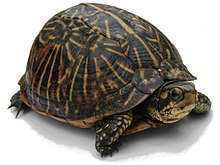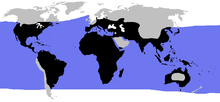River turtle
| Turtles Temporal range: Late Jurassic – Present,157–0 Ma |
|
|---|---|
 |
|
| Florida Box Turtle Terrapene carolina | |
| Scientific classification | |
| Kingdom: | Animalia |
| Phylum: | Chordata |
| Class: | Reptilia |
| Clade: | Testudinata |
| Order: |
Testudines Batsch, 1788 |
| Subgroups | |
|
Cryptodira |
|
| Diversity | |
| 14 extant families with ca. 300 species | |
 |
|
| blue: sea turtles, black: land turtles | |
Cryptodira
Pleurodira
†Meiolaniidae
and see text
Turtles are reptiles of the order Testudines (or Chelonii) characterised by a special bony or cartilaginous shell developed from their ribs and acting as a shield. "Turtle" may refer to the order as a whole (American English) or to fresh-water and sea-dwelling testudines (British English).
The order Testudines includes both extant (living) and extinct species. The earliest known members of this group date from 157 million years ago, making turtles one of the oldest reptile groups and a more ancient group than snakes or crocodilians. Of the 327 known species alive today, some are highly endangered.
Turtles are ectotherms—animals commonly called cold-blooded—meaning that their internal temperature varies according to the ambient environment. However, because of their high metabolic rate, leatherback sea turtles have a body temperature that is noticeably higher than that of the surrounding water.
Turtles are classified as amniotes, along with other reptiles, birds, and mammals. Like other amniotes, turtles breathe air and do not lay eggs underwater, although many species live in or around water.
The word chelonian is popular among veterinarians, scientists, and conservationists working with these animals as a catch-all name for any member of the superorder Chelonia, which includes all turtles living and extinct, as well as their immediate ancestors.Chelonia is based on the Greek word χελώνη chelone "tortoise", "turtle" (another relevant word is χέλυς chelys "tortoise"), also denoting armor or interlocking shields;testudines, on the other hand, is based on the Latin word testudo "tortoise". "Turtle" may either refer to the order as a whole, or to particular turtles that make up a form taxon that is not monophyletic.
...
Wikipedia
